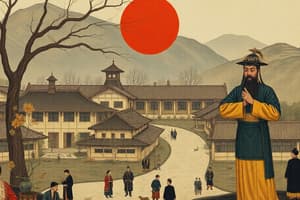Podcast
Questions and Answers
Thời kỳ nào được gọi là Xuân Thu?
Thời kỳ nào được gọi là Xuân Thu?
Thời kỳ Xuân Thu được đặc trưng bởi điều gì?
Thời kỳ Xuân Thu được đặc trưng bởi điều gì?
Trong thời kỳ Xuân Thu, quốc gia nào được coi là mạnh nhất?
Trong thời kỳ Xuân Thu, quốc gia nào được coi là mạnh nhất?
Một trong những sự kiện quan trọng xảy ra trong thời kỳ Xuân Thu là gì?
Một trong những sự kiện quan trọng xảy ra trong thời kỳ Xuân Thu là gì?
Signup and view all the answers
Thời kỳ Xuân Thu đã kết thúc vào năm nào?
Thời kỳ Xuân Thu đã kết thúc vào năm nào?
Signup and view all the answers
Study Notes
Overview of the Spring and Autumn Period
- The Spring and Autumn Period, lasting from 770 to 476 BCE, is a crucial period in ancient Chinese history.
- It followed the Zhou dynasty and marked a significant transition from a unified empire to a fragmented state system.
- Characterized by frequent warfare and political instability among numerous states.
- The period witnessed the rise of new philosophies and political thought, impacting future Chinese civilization.
Key Characteristics of the Period
- Decline of Centralized Authority: The Zhou kings lost their authority and power.
- Emergence of Powerful States: Smaller states consolidated and grew into powerful regional forces.
- Frequent Warfare: Conflicts between states were common and often intense.
- Social and Economic Changes: The existing social order was challenged, and new economic practices arose.
Political Developments
- Rise of Hegemonies: Powerful states, such as Jin, Qi, and Chu, attempted to assert dominance over other states.
- Struggle for Control: States constantly vied for territory and influence.
- Shifting Alliances: Alliances between states were based on self-interest and were not always permanent.
- Internal Conflicts: Many states were beset by internal struggles and power struggles.
- Emergence of Bureaucracy: The need for efficient governance led to the development of larger bureaucracies within the states.
Social and Economic Developments
- Population Growth: The population grew, leading to pressure on resources and land.
- Agricultural Advancements: New agricultural techniques were adopted and improved.
- Trade and Commerce: Trade and commerce expanded and became a significant element of economic life.
- Social Stratification: Social divisions became more pronounced.
- Development of New Philosophies: This period saw the emergence of important philosophical schools of thought that would shape later Chinese culture.
Important States and Figures
- Powerful States: Jin, Qi, Chu, and Wu emerged as powerful states during this era.
- Philosophers: Notable thinkers during the Spring and Autumn Period laid the groundwork for later philosophical schools. These included Confucius, although his main impact came later in the Warring States Period.
Impact of the Period
- Foundation for the Warring States Period: The weakening of central authority and the rise of powerful states paved the way for the Warring States period.
- Development of Chinese Political Thought: The challenges and conflicts of the Spring and Autumn Period spurred the development of new political and philosophical ideas that shaped the future of China.
- Cultural Development: This period fostered intellectual and cultural growth as new philosophies and ideas emerged.
Key Takeaways
- The Spring and Autumn Period was a time of significant political change and instability in ancient China.
- The decline of the Zhou dynasty and rise of powerful states led to frequent warfare.
- The period is essential for understanding the evolution of Chinese political thought and social structures.
- Development of new philosophies foreshadowed the intellectual and political developments of later periods.
Studying That Suits You
Use AI to generate personalized quizzes and flashcards to suit your learning preferences.
Description
Thời kỳ Xuân Thu, từ năm 770 đến 476 TCN, là một giai đoạn quan trọng trong lịch sử cổ đại Trung Quốc. Giai đoạn này chứng kiến sự suy giảm quyền lực của các vị vua nhà Chu và sự nổi lên của các lực lượng tiểu quốc mạnh mẽ, dẫn đến xung đột và biến động chính trị san sát. Thời kỳ này cũng đánh dấu sự phát triển của triết lý và tư tưởng chính trị mới, ảnh hưởng đến nền văn minh Trung Quốc sau này.




